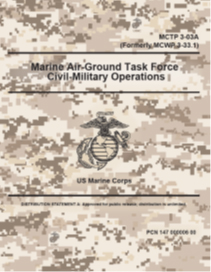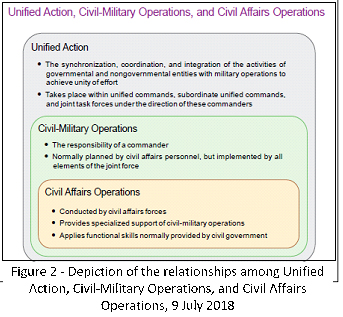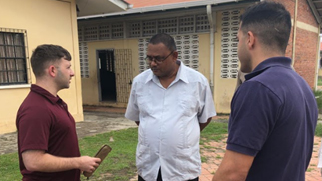The 2019 Marine Corps Civil Affairs Concept: An Ambitious Step Toward Improved Integration
Robert Boudreau, Don Newberry and Richard Phillips
Introduction[1]

Figure 1 - MCTP 3-03A, Marine Air Ground Task Force Civil-Military Operations, Released 2 May 2016.
In July 2019, the Marine Corps’ Deputy Commandant for Combat Development and Integration signed the Marine Corps Concept for Civil Affairs (“CA Concept”), which sets forth updated operational and tactical considerations for equipping and employing Marine Corps units to understand and influence the civil environment in any region of operations.[2] As the latest iteration of Marine Corps Civil Affairs (CA) doctrine, the CA Concept recommits to placing CA personnel at the critical intersection of U.S. military, interagency, non-governmental organization (NGO) and host-nation coordination in the operating environment. In this way, the Marine Corps CA community will be structured to meet the challenges of the current operating environment, provide a proactive posture, and enhance American access and influence abroad. This paper discusses practical ways in which the CA Concept may be implemented to best achieve the Commandant’s vision of the Marine Corps’ role in military engagements.
In the current operating environment, CA can be best employed in non-lethal, steady-state operational environments, where the United States is looking to shape the operating environment by strengthening international relationships while preventing its near-peer adversaries from achieving peacetime objectives (formerly described as “Phase 0” in planning doctrine). For the last hundred years, where diplomacy has failed and warfare has resulted, CA has repeatedly been revitalized and integrated with military operations during wartime. However, on the present-day battlefield, where open conflict is decreasing but “gray zone”[3] activities are increasing, CA personnel should be utilized to undermine U.S. competitors’ attempts to build military, diplomatic, economic, and informational advantages in regions of U.S. interest.[4]
Implementing the CA Concept will synchronize Civil Affairs with national-level American military strategy, with opportunities to provide a proactive forward-postured presence, enhance integration of Civil Affairs, improve access, and support information operations in the new world of emerging revisionist power competition.
National Security and Defense Strategies
The 2017 National Security Strategy (NSS) states that China and Russia, described as “great” or “revisionist powers,” are striving to shape the world consistent with their authoritarian model and gain veto authority over other nations’ economic, diplomatic, and security decisions.[5] Consistent with these ends of controlling the power structure in other nations, China is militarizing parts of the South China Sea, modernizing its military, executing influence operations, and pursuing predatory economic policies to dominate other nations, particularly in the Indo-Pacific region.[6] At the same time, Russia is seeking to dismantle NATO and overbear neighboring countries through military and other pressures in order to bolster Russian security and economic interest.[7] These activities are often at the expense of American interests and American allies. In response to these revisionist power concerns, the NSS sets forth four U.S. national interests: (i) protecting America first; (ii) promoting American prosperity; (iii) preserving peace through strength; and (iv) advancing American influence.[8] The National Defense Strategy (NDS) lays out three lines of effort to achieve these goals: (i) rebuilding military readiness; (ii) strengthening international alliances; and (iii) reforming Defense Department practices.[9] Together, the NSS and NDS form the basis of new national strategy interests, which the CA Concept is poised to meet.
CA Concept Support for NSS and NDS
The CA Concept implicitly recognizes that continued military presence through exercises and deployments in nations around the world, will play a crucial role in demonstrating American values and resolve to current and prospective allies. As the U.S. military’s operational reach spreads, many opportunities will arise to interact and partner with foreign civilian leadership, NGOs, and other entities. These opportunities should be leveraged to develop ongoing U.S. presence and eventual basing opportunities to counter hostile actors, particularly in potential ally nations. Simultaneously, the U.S. military should work to shape lasting positive perceptions in local populations impacted by the military’s presence. Incorporating CA personnel in deployment rotations as a force multiplier creates a prominent presence in areas where a full Marine Air Ground Task Force (MAGTF) presence may not be as critical, such as in areas with endemic infrastructure and public health issues but no kinetic military operations or ongoing natural disasters. CA can further provide a capability on the ground to inform a commander of the influence achieved in the region.
Forward Presence
In his Planning Guidance, the Commandant of the Marine Corps lays out his vision for the Marine Corps as the United States military’s first responders:
The Marine Corps will be trained and equipped as a naval expeditionary force-in-readiness and prepared to operate inside actively contested maritime spaces in support of fleet operations. In crisis prevention and crisis response, the Fleet Marine Force – acting as an extension of the Fleet – will be first on the scene, first to help, first to contain a brewing crisis, and first to fight if required to do so.[10]
The Commandant’s vision reinforces that Marines – including CA Marines – should be prepared to assist in maintaining a persistent forward presence, such as through conducting Expeditionary Advanced Base Operations.[11] Consistent with these goals, the CA Concept identifies persistent forward presence as critical to achieving success in the future operating environment. In order to achieve a persistent forward presence, more active component (AC) and active reserve (AR) billets should be created. Just recently the Commandant approved redistribution of 67 CA Marines to the AC. This primarily includes CA Marines who are CMO Planners on a headquarters staff and endures the deficiency of tactical requirements needed to address today’s grey zone activities.
The reserve component (RC) is the primary tactical arm of CA and has personnel distributed among three Civil Affairs Groups (CAGs). With the upcoming substantial downsizing of the CAGs in fiscal year 2020, increased forward presence will require either that RC Marines be deployed at a higher operational tempo, or that additional AC/AR billets be created. These AC/AR billets should mirror that of the RC in which CA Teams are incorporated into the tactical levels of operations, e.g. Marine Expeditionary Units, Special Purpose MAGTFs, and even more crucially, the creation of AC CAGs. The AC/AR would provide more viable options for more long-term deployments than the RC as there are more constraints on the RC due to higher costs, longer dwell times, and upcoming downsizing of the RC.[12] Through this proposed reorganization, Marine Corps CA can better provide proactively-postured stabilization capabilities.
Integration with U.S. Diplomatic Missions
The NDS notes that “[e]ffectively expanding the competitive space requires combined actions with the U.S. interagency to employ all dimensions of national power.”[13] Along similar lines, the CA Concept discusses the need for a whole-of-government approach to international relations, which will require increased coordination between Department of Defense (DoD) and Department of State (DoS) organizations. This focus on interoperability will be critical to the future of Civil Affairs.

Figure 2 - Depiction of the relationships among Unified Action, Civil-Military Operations, and Civil Affairs Operations, 9 July 2018.
CA personnel are uniquely trained to interact and develop synergies with interagency, NGO, and international partners, conceptually described as enhanced unified action. In recognizing that unified action is needed beyond the bounds of just DoD, the CA Concept provides a necessary update to the narrower joint doctrine, depicted to the right in Figure 2. CA should be employed to support foreign assistance programs and integrate with U.S. Embassies, and thereby provide opportunities to assist the Chief of Mission (COM) and integrate civil military operations (CMO) with COM objectives, further bridging the gap between the DoD and DoS.
For CA personnel to integrate most effectively with the DoS, CA teams could be deployed on short-term rotational bases to U.S. Embassies.[14] The concept of embedding CA personnel with Embassy staff is not new: Army CA employs Civil Military Support Element (CMSE) embassy teams around the world, used in support of the Army’s civil affairs engagement programs.[15] In executing their mission, CMSE teams maintain a long-term relationship with the U.S. Mission and the host country. They are tasked to improve DoD’s visibility in the HN, to provide access and to influence the host nation, and to generate long-term positive attitudes and good will for the U.S. government and DoD. The Marine Corps CA community should emulate this as means of prepositioning CA personnel for proactive civil engagement.
CA teams can be used to enhance coordination between DoD, DoS, NGOs, and intergovernmental organizations in furtherance of American strategic objectives. The CA Concept emphasizes that cultural learning must be expanded to include foreign area and regional studies, with an end goal of developing enhanced understanding of the civil environment, which would typically include identification and analysis of institutional influences within the area. One means of doing so would be to distribute regional responsibilities at the Group level, and to enable CA personnel to maintain contact with the regional influencers. For example, Foreign and Regional Area Officers develop expertise on particular countries and regions; CA Marines can partner with these local subject-matter experts to stay abreast of local developments, to identify local leaders, NGOs and other institutions with special interest in a particular area, and, where feasible, to open dialogues in order to maintain a current civil assessment or prepare for upcoming exercises or other missions.
Building Partnerships with Developing Nations
As the U.S. military footprint in Iraq and Afghanistan has decreased, the need for military involvement in host-nation governance has similarly declined. The United States’ revisionist competitors, however, have increasingly vied for influence over developing nations through economic investment, diplomatic pressures, and military exercises.[16] This increased hostile influence creates an opportunity for the U.S. to focus military engagements on nation development, particularly in the areas of good governance and stability in nations vulnerable to Chinese and Russian actions.
Figure 3 - 4th CAG Personnel engage a school administrator in New Amsterdam, Guyana during New Horizons 2019.
The CA Concept points out that civil assessments and identification of civil vulnerabilities can be conducted by CA specialists in areas which typically fall within the civil, rather than military, sector. CA personnel bring an organic capability to assist in more substantial nation development activities geared towards good governance through governance, economic stability, infrastructure and public education specialties. These capabilities can be integrated with international exercises, TSC, and other activities. Thus, for example, a CA detachment working with host nation government officials will be able to develop and disseminate clearer understanding of diplomatic relations and ways to facilitate military collaboration. These relationships will in turn increase U.S. ability to defend allies from malign actors, should the need arise.
Simultaneously, CA provides a unique capability to coordinate aid while developing trust-building relationships, which the MAGTF cannot otherwise accomplish on its own. Inviting NGOs, such as international aid organizations, to participate with military and Embassy activities will increase the effectiveness of nation-building activities and reduce host nation dependence on American military assistance in event of a crisis. Depending on the level of access provided by a host nation, CA efforts can help to move forward a wide variety of U.S. government activities within the host nation. Acting in tandem with the U.S. diplomatic mission, CA teams can liaise between the Security Cooperation Office/Defense Attaché and multiple host nation military initiatives. Moreover, CA can enhance the interaction between Embassy personnel, information networks, business interests, and ultimately U.S. military initiatives, thus making CA a force multiplier for MAGTF and other U.S. military operations.
CA should still focus on maintaining long-term relationships with interagency, host-nation, and international partners. For example, certain exercises in the SOUTHCOM area of responsibility are conducted with particular nations on a cyclical basis, rather than with the same nations each time.[17] These exercises should not be treated as “fired and forgotten” once the U.S. military leaves the AOR. Rather, CA Marines, as ground-level coordinators of CMO, should be utilized to maintain contact with local leaders, NGOs and other partners, which, in a sense, simulate a forward presence – long after exfiltration has been executed. These partnerships will increase American military access to nations vulnerable to growing Chinese and Russian power and influence.
Support to Operations in the Information Environment (OIE)
Figure 4 - Civil Information Management Process
Along the spectrum of irregular warfare, OIE present new threats, but also new opportunities, for the United States and its partners. Current joint doctrine contemplates CA interaction with the information environment only in terms of civil information management (CIM), depicted in Figure 4.[18] However, the CA Concept views CA as filling a much more hands-on role with the Marine Expeditionary Force Information Groups (MIGs), particularly to address the civil aspect of targeting in the informational battlespace.
CA personnel often function as ambassadors for military engagements and fill a unique position to identify the value points of the targeted populace. Civil engagements provide a means to obtain boots-on-the-ground insight into host-nation vulnerabilities in the information realm. Traditional CIM activities, including collection, analysis, and dissemination, will continue to be used to create the civil estimate and to conduct civil preparation of the battlespace.[19] To strengthen the effectiveness of MAGTF information capabilities, CA should be integrated into the MIGs, where CA personnel can collaborate in a unified fashion with other information related capabilities (IRC), such as psychological operations and communications strategy and operations. This will position CA forces to be both proactive and integrated with other American actors in the information space.
Conclusion
In summary, the CA Concept demonstrates that CA meets a critical need to connect U.S. military activities to the civil environments impacted by operations around the globe, and places CA development and employment in a place where it can best be utilized to meet the objectives laid out in the National Security and Defense Strategies. Properly and effectively implementing the CA Concept will synchronize CA with national-level American military strategy, enhance integration of CA, provide a proactive posture, and improve American influence and access in the new world of emerging revisionist power competition. As the Unites States’ major competitors continue to vie for power and influence in the world, the U.S. military’s ability to understand and reach leaders, populations, and organizations in allied and other nations of interest will play an increasingly important role. Accordingly, commanders should seek not just to incorporate CA personnel at the planning level, but also to employ CA capabilities at the tactical level to help shape the civil environment to achieve maximum effects on nations of strategic importance to the United States. Through embedding CA in embassies, forward deploying personnel to create a persistent presence, building partnerships, and conducting CIM in conjunction with other IRC, a MAGTF commander can reach areas and create influence where they may not otherwise have access, leveraging CA as a force multiplier. The message is clear: invest in CA personnel, and thereby ensure that the Marine Corps can meet the challenges of changing policies and support the NSS and NDS, by leveraging the civil component of the operating environment.

End Notes
[1] Many of the concepts discussed in this paper are the subject of an unpublished draft white paper which has been simultaneously prepared by officers of 3rd and 4th Civil Affairs Groups. The authors of this paper collaborated on that project as well, along with Majors Michael Aniton, Christopher Bridger, Aaron Clinger, Marvin Mathelier, Christopher Miles. It is not anticipated that the white paper will be publicly disseminated.
[2] United States Marine Corps, Marine Corps Concept for Civil Affairs (CA Concept), 19 July 2019. Not approved for public release.
[3] Hicks, Kathleen H, et al., By Other Means – Part 1: Campaigning in the Gray Zone, A Report of the Center for Strategic & International Studies International Security Program, July 2019, retrieved from https://csis-prod.s3.amazonaws.com/s3fs-public/publication/190708_Hicks_GrayZone_interior_v3_FULL_WEB_final.pdf.
[4] See The White House, National Security Strategy of the United States (December 2017) ( NSS) p. 2; Hicks, Kathleen H, et al., By Other Means – Part 1: Campaigning in the Gray Zone, A Report of the Center for Strategic & International Studies International Security Program, July 2019, retrieved from https://csis-prod.s3.amazonaws.com/s3fs-public/publication/190708_Hicks_GrayZone_interior_v3_FULL_WEB_final.pdf.
The “DIME” (diplomatic, informational, military and economic) acronym is a construct commonly used to describe the several instruments of national power, and is particularly relevant in any discussion of joint military and interagency activities. See generally Joint Staff, Joint Doctrine Note 1-18 “Strategy,” 25 April 2018 pp. vii-viii.
[5] NSS at 25.
[6] U.S. Department of Defense, Summary of the 2018 National Defense Strategy of the United States of America (NDS) at 1-2.
[7] Ibid p. 2.
[8] Ibid pp. 3-4.
[9] Ibid p .5.
[10] Commandant’s Planning Guidance, 38th Commandant of the Marine Corps at 1.
[11] Ibid p. 11.
[12] Ibid p. 3.
[13] NDS at 5
[14] Ibid.
[15] See generally Department of the Army, GTA 41-01-001, Civil Affairs General Concepts, January 2019 at 34.
[16] For example, see Chibarirwe, Anthony, “China Expands Economic, Military Influence in Sri Lanka,” The Trumpet, 1 August 1018, retrieved from https://www.thetrumpet.com/17554-china-expands-economic-military-influence-in-sri-lanka.
[17] See generally U.S. Southern Command “New Horizons l Beyond the Horizons 2019” webpage, last visited 25 August 2019, retrieved from https://www.southcom.mil/Media/Special-Coverage/New-Horizons-Beyond-the-Horizon-2019/.
[18] JP 3-57, Figure C-2, obtained at page C-4.
[19] Ibid.
About the Author(s)
Comments
We are committed to…
We are committed to providing our clients with exceptional solutions while offering web design and development services, graphic design services, organic SEO services, social media services, digital marketing services, server management services and Graphic Design Company in USA.
